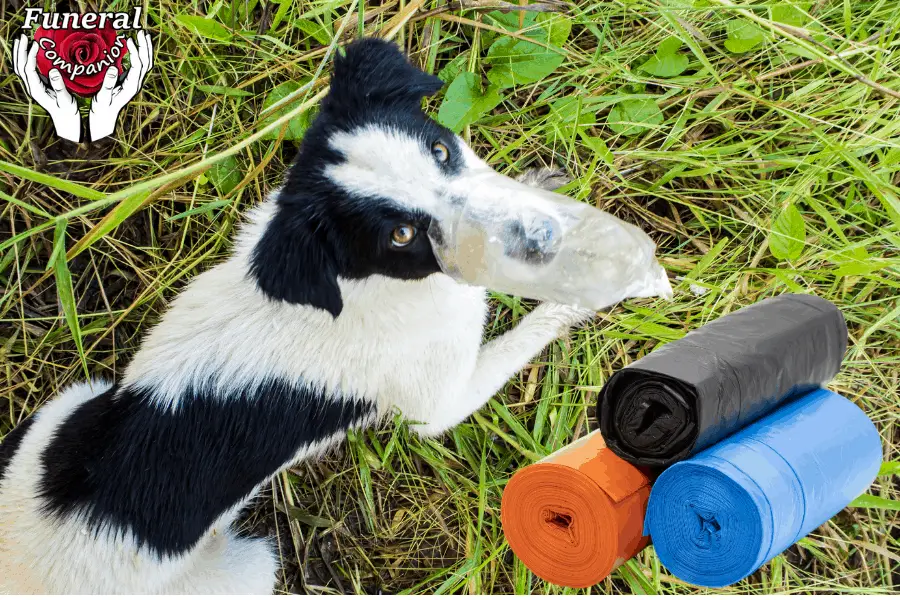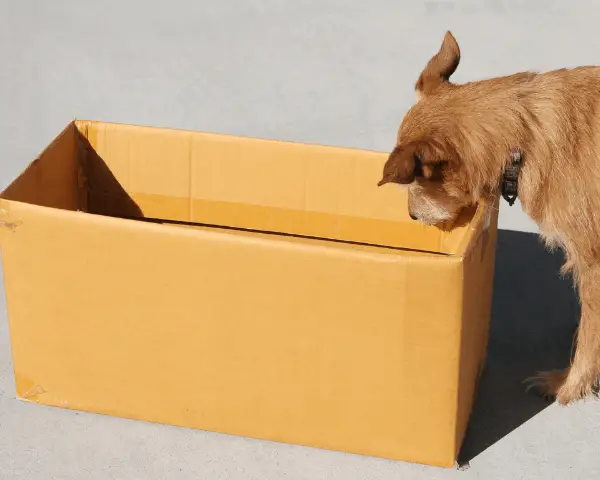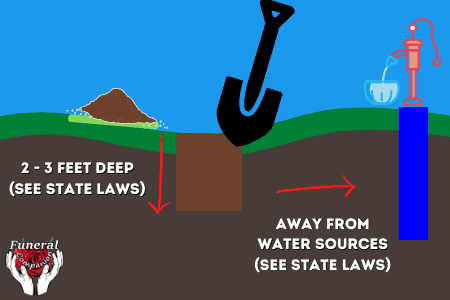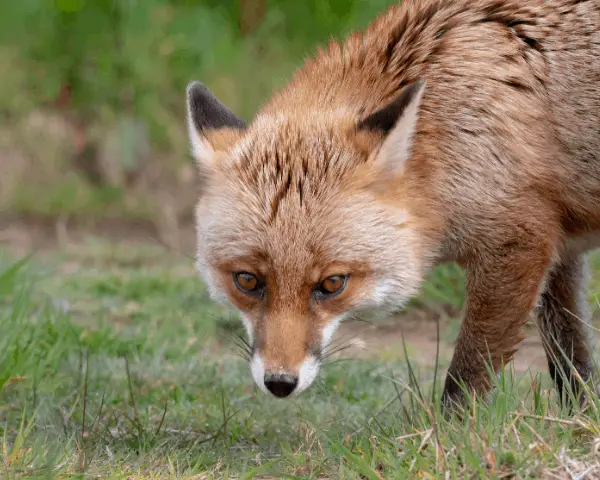Every dog owner will have to face the sad passing of their pet at least once in their lives. It’s happened to me three times and is certain to occur again in the near future.
If you are lucky enough to have the space and resources, you will want to lay your beloved doggie to rest in your own backyard.
However, this is not an every day event and is fraught with various pitfalls.
Using a plastic bag to bury your deceased dog is a bad idea. It not only harms the environment but also adds no protection against scavengers, soil contamination, or water pollution. Furthermore, the use of plastic trash bags is unfitting for a former member of the family in terms of respect.
Before you rush off to dispose of your pet, which you do need to do fairly quickly, take a moment to clarify a few important points in the following article about burying a dog.

Why a plastic-free burial?
The simple fact of the matter is that using a plastic bag or container in a pet burial, dog or otherwise, has few benefits. In fact, it has a lot of drawbacks.
Plastic isn’t sanatory
Probably the leading cause of using plastic to bury a dog is that it seems ‘clean’ in some sort of way.
Despite loving our pets dearly, death in the 21st century comes across as a little dirty and a plastic trash bag seems to keep all of that nastiness neatly contained.
However, plastic is just as hard to fully sanitize as any other material and it won’t keep your yard clean and certainly not the soil which will surround your dog as he or she breaks down.
Using plastic is not a good way to prevent contamination of your yard if your pet has been diseased or if you are afraid of anything from the remains getting into a water supply.
In these cases burial probably isn’t the best option, and I’ll touch on that later on in this article.

Plastic isn’t quicker
In no way will plastic speed up the process of decomposition. Not that many dog owners are waiting around to reclaim the gravesite, but plastic really doesn’t have any effect on the speed of decay.
In layman terms, decomposition begins from within the body and then will often be added to by bacteria from the soil around the grave.
Plastic won’t really do anything to preserve or break down remain more quickly, so using it for this purpose is pretty futile.
Plastic is a pollutant
For me personally, the most important reason not to use plastic in the burial process of a dog is that it just adds to the pollution of the planet.
Although plastic doesn’t affect the natural decomposition of your dog it will take much longer to break down itself.
According to sprep.org, plastic bags take up to half a millennium to break down, and then they don’t ever really decompose but rather photo-degrade which continues to pollute the environment as microplastic.
I just don’t think that’s a very good legacy for your pet.
Plastic is disrespectful
In addition to the negative legacy that using plastic gives to your dog’s passing, it’s also a little mean to their dignity.
As a dog owner, you know that these beautiful beings are more than mere animals. They were, and are, full of personality and love.
Do you really want to send them to their final resting place wrapped up in what you use to throw out the garbage?
Is there any reason to use a plastic bag to dispose of your dog?
There are only really two reasons why you might still use a plastic bag to bury a dog, only one of them is actually a good one.
This is a free world and if you really want to do it, hey, nobody is going to judge you and as long as you are satisfied that’s really all that matters.
The only valid reason I can think of using a plastic bag to bury your dog is if for some reason in the future you plan to move it a rebury it.
So dog owners have been known to take their deceased pets with them when they move or because of some sort of construction project over the grave.
Others also have requested to be buried with their pets, which is much more likely to be allowed if they opt to be buried on their own property.
I recently looked into getting a loan and I’ve actually had a good experience with Supermoney.com. For me, it was a car loan but I spoke to them about a dedicated funeral expenses loan, which is one of the services they offer and was quite impressed. To see if you could qualify, check out my link here.
Do you need a casket?

So, as we’ve answered the question about using a plastic bag or sheet to bury your dog in, do you actually need to bury it in anything at all?
From a practical point of view, you don’t need to bury your dog in a casket or any other sort of container. For the protection of your dog’s remains, depth is much more important than a physical shied against scavengers. For emotional reasons, a blanket or article of clothing is probably necessary.
If we are talking about a backyard burial, which is a choice that many owners make, there aren’t any rules to say you must have a container.
As I said, growing up we lost 3 dogs and my Dad, brothers and I each helped with the burial of all or one of those four-legged family members.
Each time we just wrapped Fern, Tessie, or Todd in a blanket and made sure that the grave was dug deep enough to provide protection against marauding foxes and other critters.
I’d recommend you do the same.
If you want to pick up a quality urn or memorial for your beloved pet I would really recommend OneWorld Memorial which offers a wide range of products for both pet and human memorials. I was personally very happy with an urn I bought from them recently.
How to dig a dog’s grave
So you know that you probably can ditch that plastic bag now, but how about digging the grave? Well, let’s just go over a few important points. It’s unlikely that you’ve had much experience in this area.
Remember that although death is a natural part of life, we want to keep your deceased dog from affecting your future life in anyway.
By this I mean, choose the right place to dig the grave.

Things to check first:
- Is there a well or water source in the yard?
- Are there any utilities running under your yard?
- have any other pets been buried in the yard before?
- What is the drainage and elevation of your yard like?
Water sources
If you have a well or spring on your property be very careful about burying a pet, or person for that matter, anywhere near it. You could very easily contaminate your water source and get all sorts of nasty diseases according to this source.
Utilities and other buried cables
calling your local utilities companies to enquire about lines and cables on your property before you dig is a lot less embarrassing than calling them after.
You will be amazed at how similar a shallowly buried cable looks like a tree root and how quickly you can cut through your grandfather’s cable TV line.
That was a job I didn’t get paid for!
Other occupants in the yard
Unless previous owners have told you this you may not know but for your own family, just ask if and where previous pets have been laid to rest.
You don’t want any surprises.
Know your water table
Much on the same line as water sources, you should choose the gravesite based on how your backyard floods and drains.
Try to place the grave on the highest and driest parts of the land rather than where water collects or floods. This will avoid contamination of the area as much as possible.
It’s even possible that using a plastic bag for burial could add to this type of contamination.
Will other animals dig up the grave?

Scavenging animals such as foxes or Coyotes and even other pets will certainly dig up your deceased dog if they know it is there. Of course, burying your dog in a plastic bag won’t stop this at all.
To avoid this, make sure that you dig your dog’s grave deep and plenty wide enough. As a general rule three feet (91.5 cm) is recommended, but don’t forget to consider the size of your dog.
Burying the dog this deep will provide a barrier to the odor reaching the surface which is the main reason why another animal might investigate the grave.
Another great method is to add a layer of a harder material that will effectively block other animals from digging down. My family would always place a paving slab or large stone about 1 to 2 feet down.
Basically, you would place your dog at the bottom of a three foot hole (making sure it’s long enough), then fill it about a third of the way up or until the body is covered.
Following that you’d carefully place paving stones to cover the body and as much of the grave as possible, then fill up the rest of the grave.
You can also cover the surface of the grave with stones, but you may not wish to make the gravesite so discernible.
Where can you bury a dog?
Generally, if you are a homeowner you can bury your pet in most states in the USA and most countries. Be sure to double-check local laws, however.
If you rent, have a homeowners association, or don’t own the land you want to use then you would have to seek the permission of the landowner or local authorities.
If you aren’t a homeowner and don’t have permission then you can always consider a pet cemetery as they would have the added bonus of digging and burying the dog for you.
Should you place a headstone?
Personally, I don’t favor the idea of placing a headstone on a backyard pet burial. I’ve always used a more natural way of marking my deceased dog’s last resting place.
One of the reasons you probably don’t want to have a genuine headstone to mark a pet grave is if int he future you want to sell your house.
Although not illegal, having a known pet burial in a garden could be enough to dissuade a potential buyer. Having a beautiful tree or bush over the ‘secret’ grave may have a very different effect.
Is burial actually the best option?
For most natural deaths and where the dog’s owners also own their home, burial can be the quickest and cheapest method of disposing of the remains.
However, digging a grave, even a smaller pet one, is time-consuming and even emotionally draining.
Where the pet has died from a disease or is rather small or big, cremation may be safer and more logical.
In some cases, traditional cremation and burial may not be the greenest options, in this case, water cremation may be a better fit.
How quickly should you bury a dog?
Decomposition of dogs, as well as other animals, can begin as soon as 24 hours after death. In hot climates, the process will be accelerated so burying the pet should begin within 48 hours to avoid any unpleasantness.
Artificial refrigeration or cooling can give you additional time but burial should take place within 7 days ideally. Some states even stipulate that you must bury your pets within a certain time limit, even as quickly as 12 hours after death.




